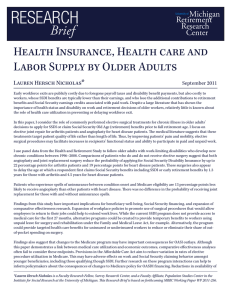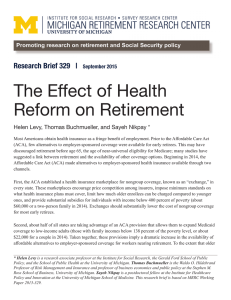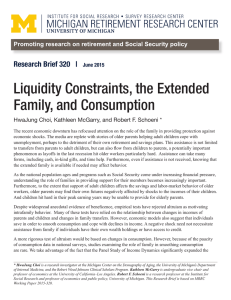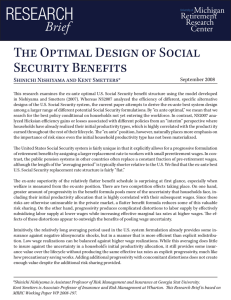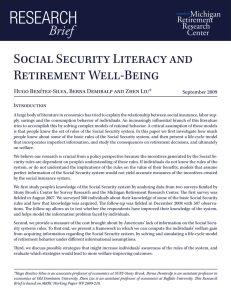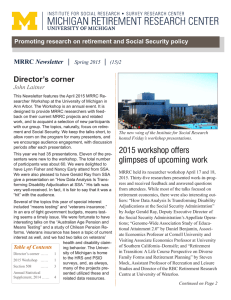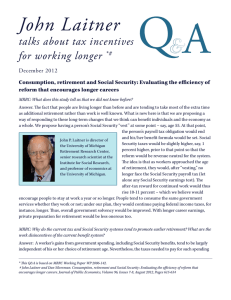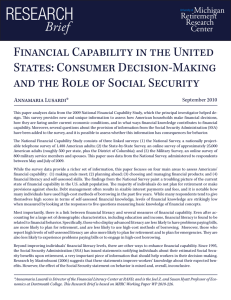Q A ER Q:
advertisement
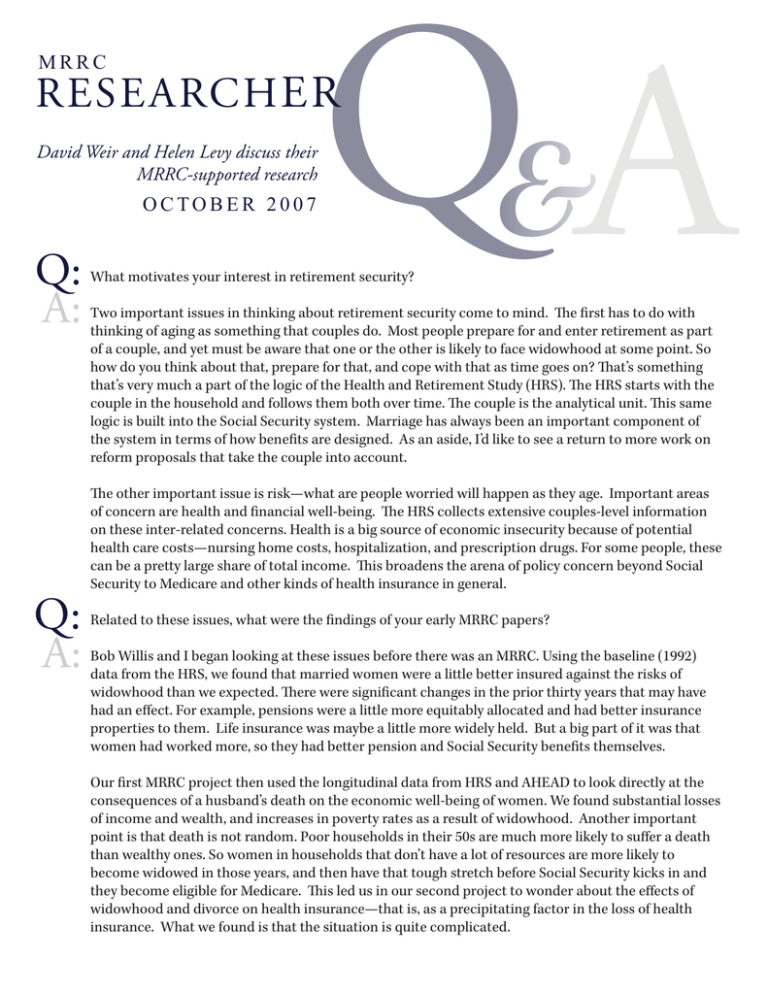
MRRC QA RESEARCH ER David Weir and Helen Levy discuss their MRRC-supported research OCTOBER 2007 Q: A: What motivates your interest in retirement security? Two important issues in thinking about retirement security come to mind. The first has to do with thinking of aging as something that couples do. Most people prepare for and enter retirement as part of a couple, and yet must be aware that one or the other is likely to face widowhood at some point. So how do you think about that, prepare for that, and cope with that as time goes on? That’s something that’s very much a part of the logic of the Health and Retirement Study (HRS). The HRS starts with the couple in the household and follows them both over time. The couple is the analytical unit. This same logic is built into the Social Security system. Marriage has always been an important component of the system in terms of how benefits are designed. As an aside, I’d like to see a return to more work on reform proposals that take the couple into account. The other important issue is risk—what are people worried will happen as they age. Important areas of concern are health and financial well-being. The HRS collects extensive couples-level information on these inter-related concerns. Health is a big source of economic insecurity because of potential health care costs—nursing home costs, hospitalization, and prescription drugs. For some people, these can be a pretty large share of total income. This broadens the arena of policy concern beyond Social Security to Medicare and other kinds of health insurance in general. Q: A: Related to these issues, what were the findings of your early MRRC papers? Bob Willis and I began looking at these issues before there was an MRRC. Using the baseline (1992) data from the HRS, we found that married women were a little better insured against the risks of widowhood than we expected. There were significant changes in the prior thirty years that may have had an effect. For example, pensions were a little more equitably allocated and had better insurance properties to them. Life insurance was maybe a little more widely held. But a big part of it was that women had worked more, so they had better pension and Social Security benefits themselves. Our first MRRC project then used the longitudinal data from HRS and AHEAD to look directly at the consequences of a husband’s death on the economic well-being of women. We found substantial losses of income and wealth, and increases in poverty rates as a result of widowhood. Another important point is that death is not random. Poor households in their 50s are much more likely to suffer a death than wealthy ones. So women in households that don’t have a lot of resources are more likely to become widowed in those years, and then have that tough stretch before Social Security kicks in and they become eligible for Medicare. This led us in our second project to wonder about the effects of widowhood and divorce on health insurance—that is, as a precipitating factor in the loss of health insurance. What we found is that the situation is quite complicated. We had expected there to be a strong relationship because many women’s health insurance comes from their husband’s job. If the husband dies, they lose their coverage. Indeed, we see that this happens, but it isn’t the whole story. There are other ways to continue coverage, COBRA for example. The upshot is that people seek out health insurance. By and large those who need it tend to seek it out, and those who do not seek it tend to be those who at least think they don’t need it or could do without it. While it is certainly a problem overall for our society that there are so many people without health insurance, when you look at the people you would be most worried about losing it, they seem to find it. Importantly, there is Medicaid coverage for those with really low resources. Q: A: Talk about your work with Helen Levy on Medicare Part D. While all eyes have been on Social Security reform, the impact of reform is not really going to affect today’s elderly. Prescription drug coverage, on the other hand, is something that affects them right now. Medicare Part D was interesting because it is a model of how you can add a government subsidy without undermining the private market. The HRS saw this as something of great interest that we would want to study for a long time to come. So we were able to go into the field with questions about Part D even as the policy was being implemented. We were interested in who took-up the benefit and who didn’t. There is also a subsidy program which pays Part D premiums and drug co-payments for low-income folks, and we were interested in whether people signed up for that also. Social Security runs the subsidy and was charged in part with public information, getting information out there about the program, accepting the applications and reviewing them, determining who was eligible and who wasn’t. For most people, if you’re in a Part D plan, your premium is deducted from your Social Security check. Ideally, in the future we will be able to take the self-reported information we have from the HRS and link it to the Social Security administrative records to know for sure who enrolled in what. The information we gathered in the HRS allows us to at least take a first look at how this program has worked. In 2005, we asked people what they knew about Part D just as it was rolling out. In 2006, we began to ask what they had actually done. We did a mail survey to get people to tell us specifically what drugs they take, how they pay for them, how their coverage works. We will be going back to ask them again about specific drugs, so we will be able to see what impact the program has had on that. We’ve also done an internet survey to try to get a little more complex information that doesn’t work as well with either an interview or the mail survey method. In 2005, we asked people how they felt about what was happening with Medicare, about the choice issues. It’s critical to the whole idea of these kinds of policies that you rely on the market to be efficient and cut costs. For the market to work, people have to make choices. Even with the on-line tools that were and are available to help, it is still a pretty complicated decision to make the best choice for you. So we found in 2005 that most people were aware that this was coming along, but many said they didn’t know much about it and were generally confused. Then in 2006, we asked them, what did you do and how did you feel about it, and people by and large are pretty happy. This was a bit surprising but not that difficult to understand. It is often the case that there is anxiety about the unknown, and that may be some of what we’re seeing here. Secondly, people saw only complexity going into Part D. It turns out that many people didn’t have to do anything. Retired people with good coverage from their employers mostly stayed put, and people on Medicaid were automatically enrolled into Part D. And for people who actually needed coverage and didn’t have it, there’s a big gain. So once people began to realize this, they began to feel better about it. The hardest decision faced people who had to choose among the many private plans. What differentiates the plans most is which drugs they cover or which drugs they treat as high co-pay or low co-pay. However, because of Medicare’s requirements for coverage, most people could adapt to any plan by changing the 2 MRRC October 2007 brand of drug they took. So most people really couldn’t go wrong with any of the plans available. Going forward, we’re asking people to rate different features of their plan. We have some of this from 2005, and it seems clear that people who report that their plan doesn’t cover certain drugs have much lower satisfaction. It may be that people would rather spend a little more per month to have that choice. We ask “do you feel that you are taking the best drug for this problem?” As we gather more information about the drugs people are taking, we’ll be able to see if they are feeling that their choices are constrained. Q: A: Who didn’t sign up? Are there people who got left out? For the most part, people who didn’t enroll in Part D are those who don’t use prescription drugs. This may be a rational economic choice, because there is a premium somewhere around $400 a year. The subsidy looks different – many low-income respondents say they didn’t sign up or don’t know anything about it - and we are working right now to try to figure out how much is problems with self-report and how much is real. The administrative data suggest that many people who were eligible for the subsidy are not getting it. The HRS data tend to support that, but what’s interesting is that many of them did sign up for Part D but not for the subsidy—something that the aggregate numbers can’t tell you. It all suggests that even though there is satisfaction with how things turned out, there may still be a lack of understanding of all the details involved. We are going to try another way of asking about the subsidy in 2008. We’ll be using questions modeled on the Medicare Current Beneficiary Survey that ask if the respondent knows that there is a program that can help with costs and then whether or not they have applied for it. However, even though our counts appear to be low, the Social Security administrative data suggest that there’s not enough people in this program based on estimates of eligibility. So there’s a lot of work to be done to find out what is happening with those who are eligible for the subsidy. We did ask people who said they didn’t apply why they didn’t and some said because they didn’t want hand-outs. I think part of the success of Social Security and Medicare take-up has been that people do not perceive these programs as hand-outs. It’s a bit of a conundrum in social welfare policy generally. You want to be sure that the poorest people are being covered. But as soon as a program is means-tested, there is stigma and political vulnerability. Sources: The Economic Consequences of Widowhood by David Weir, Robert J. Willis and Purvi Sevak WP 2002-023, April 2002 Widowhood, Divorce, and Loss of Health Insurance Among Near Elderly Women: Evidence from the Health and Retirement Study by David Weir and Robert J. Willis WP 2003-040, April 2003 Take-Up of Medicare Part D and the SSA Subsidy: Early Results from the Health and Retirement Study by Helen Levy and David Weir WP 2007-163, October 2007 MRRC October 2007 3 4 MRRC October 2007 David R. Weir (Ph.D. in Economics, Stanford University, 1983; A.B. in History, University of Michigan, 1976) is Research Professor in the Survey Research Center, Institute for Social Research (ISR) at the University of Michigan and Director of the Health and Retirement Study (HRS), funded by the National Institute on Aging (NIA). Prior to joining ISR, he was Research Associate in the Harris School of Public Policy at the University of Chicago, and the recipient of a Special Emphasis Research Career Award in the Economics and Demography of Aging from NIA. Helen Levy is a Research Assistant Professor at the University of Michigan’s Institute for Social Research. She is also an Assistant Research Scientist in the School of Public Health at the University of Michigan. Levy is a labor and health economist whose research focuses on health insurance, with special attention to the causes and consequences of not having coverage. Before coming to the University of Michigan Levy was an Assistant Professor at the University of Chicago’s Harris Graduate School of Public Policy Studies. She was a Robert Wood Johnson Foundation Scholar in Health Policy Research at the University of California at Berkeley. Levy holds a BA from Yale in mathematics and history and a Ph.D. in economics from Princeton University. THE MICHIGAN RETIREMENT RESEARCH CENTER IS SUPPORTED BY A COOPERATIVE AGREEMENT WITH THE SOCIAL SECURITY ADMINISTRATION (10-P-98362-5-04). DIRECTOR — JOHN P. LAITNER ASSOCIATE DIRECTOR FOR EXTERNAL RELATIONS — AMANDA SONNEGA CENTER ADMINISTRATOR — BECKY BAHLIBI CENTER SECRETARY — JESSICA TAYLOR DESIGN SPECIALIST — KELLYN JACKSON REGENTS OF THE UNIVERSITY OF MICHIGAN Julia Donovan Darlow, Ann Arbor Laurence B. Deitch, Bingham Farms Olivia P. Maynard, Goodrich Rebecca McGowan, Ann Arbor Andrea Fischer Newman, Ann Arbor Andrew C. Richner, Grosse Pointe Park S. Martin Taylor, Gross Point Farms Katherine E. White, Ann Arbor Mary Sue Coleman, ex officio Michigan Retirement Research Center Institute for Social Research University of Michigan 426 Thompson Street, Room 3026 Ann Arbor, MI 48104-2321 Phone: (734) 615-0422 Fax: (734) 615-2180 E-mail: mrrc@isr.umich.edu Web: http://www.mrrc.isr.umich.edu Michigan Retirement Research Center University of
